Forecasting Trends in Electrical Energy Efficiency in the Food Industry
Abstract
1. Introduction
2. Forecasting Methods
2.1. Logistic Regression Method
2.2. Decomposition Method
3. Methodology
3.1. Cumulative Electricity Consumption Difference Analysis
3.2. Forecasting and Comparative Analysis of Electricity Usage Efficiency
4. Results and Discussions
5. Conclusions
Author Contributions
Funding
Data Availability Statement
Acknowledgments
Conflicts of Interest
References
- Pradella, A.M.; Loures, E.F.R.; Costa, S.E.G.; Lima, E.P. Energy Efficiency in the Food Industry: A Systematic Literature Review. Arch. Biol. Technol. 2019, 62, e19190002. [Google Scholar] [CrossRef]
- Clairand, J.-M.; Briceño-León, M.; Escrivá-Escrivá, G.; Pantaleo, A.M. Review of Energy Efficiency Technologies in the Food Industry: Trends, Barriers. IEEE Access 2020, 23, 48015–48029. [Google Scholar] [CrossRef]
- Corigliano, O.; Algieri, A. A comprehensive investigation on energy consumptions, impacts, and challenges of the food industry. Energy Convers. Manag. 2024, 23, 100661. [Google Scholar] [CrossRef]
- Pimenov, D.Y.; Der, O.; Patel, G.C.M.; Giasin, K.; Ercetin, A. State-of-the-art review of energy consumption in machining operations: Challenges and trends. Renew. Sustain. Energy Rev. 2025, 224, 116073. [Google Scholar] [CrossRef]
- Charalambous, C.; Polycarpou, A.; Efthymiou, V.; Georghiou, G.E. Enhancing Energy Efficiency and Sustainability with Hybrid AC/DC Microgrids for Energy Transition. In Proceedings of the 3rd International Conference on Energy Transition in the Mediterranean Area (SyNERGY MED), Limassol, Cyprus, 21–23 October 2024; pp. 1–5. [Google Scholar] [CrossRef]
- Zheng, S.; Zhang, Y.; Zhou, S.; Ni, Q.; Zuo, J. Comprehensive Energy Consumption Assessment Based on Industry Energy Consumption Structure Part I: Analysis of Energy Consumption in Key Industries. In Proceedings of the IEEE 5th International Electrical and Energy Conference (CIEEC), Nangjing, China, 27–29 May 2022; pp. 4942–4949. [Google Scholar]
- Pasiopoulou, I.D.; Vomva, S.A.; Papagiannis, G.K.; Bouhouras, A.S.; Filippidis, S.P.; Christoforidis, G.C. Monitoring the energy behavior of SMEs before and after Energy Efficiency measures: A case study. In Proceedings of the 57th International Universities Power Engineering Conference (UPEC), Istanbul, Turkey, 30 August–2 September 2022; pp. 1–6. [Google Scholar]
- Ratsame, P.; Chansri, P. Analysis of Electrical Energy Consumption Efficiency Trends Using Visualization Tools. In Proceedings of the 2024 8th International Conference on Power Energy Systems and Applications (ICoPESA), Hong Kong, 24–26 June 2024; pp. 333–337. [Google Scholar] [CrossRef]
- Kongthon, S.; Rakpiamsuk, S.; Rattanawong, W.; Ratsame, P.; Chansri, P. Analysis of Electrical Energy Consumption Efficiency Trends, Case Study: A Textile Industry. In Proceedings of the International Electrical Engineering Congress (iEECON), Hua-Hin, Thailand, 5–7 March 2025. [Google Scholar]
- Liu, M.; Mo, C.; Wang, H. Short-term Power Load Forecasting Model Based on CNN-GRU and Dual Attention Mechanism Hybrid Neural Network Model. In Proceedings of the 8th Asia Conference on Power and Electrical Engineering (ACPEE), Tianjin, China, 14–16 April 2023; pp. 1769–1773. [Google Scholar] [CrossRef]
- Montgomery, D.C.; Jennings, C.L.; Kulahci, M. Introduction to Time Series Analysis and Forecasting, 3rd ed.; Wiley: Hoboken, NJ, USA, 2024. [Google Scholar]
- Joseph, M. Modern Time Series Forecasting with Python, 2nd ed.; Packt Publishing: Birmingham, UK, 2024. [Google Scholar]
- Liu, G.; Xiao, F.; Lin, C.-T.; Cao, Z. A Fuzzy Interval Time-Series Energy and Financial Forecasting Model Using Network-Based Multiple Time-Frequency Spaces and the Induced-Ordered Weighted Averaging Aggregation Operation. IEEE Trans. Fuzzy Syst. 2020, 28, 2677–2690. [Google Scholar] [CrossRef]
- Sangngamseung, N.; Sanarak, A.; Khunwiset, S.; Ratsame, P.; Chansri, P. Comparison Forecasting Methods for Electrical Energy Demand: In Case Study Luggage Manufacturing Industry. In Proceedings of the 13th International Electrical Engineering Congress (iEECON), Hua-Hin, Thailand, 5–7 March 2025; pp. 1–4. [Google Scholar]
- Khaled, E.U.; Bayezid, A.A.; Mamun, A.A.; Islam, M.A.; Ahmed, M.R.; Shahabuddin, A.K.M.; Ali, M.M.N. Long Term Electrical Energy Planning Using LEAP: A Case Study for Bangladesh. In Proceedings of the 10th IEEE International Conference on Power Systems (ICPS), Cox’s Bazar, Bangladesh, 13–15 December 2023; pp. 1–6. [Google Scholar] [CrossRef]
- Zahari, N.E.M.; Mokhlis, H.; Mansor, N.N.; Sulaima, M.F. Modelling of Hybrid Energy System for Demand-Side Management: A Case Study of Industrial Customer in Malaysia. In Proceedings of the Innovations in Power and Advanced Computing Technologies (i-PACT), Kuala Lumpur, Malaysia, 8–10 December 2023; pp. 1–6. [Google Scholar] [CrossRef]
- Podgorelec, V.; Pečnik, Š.; Lahovnik, Z.; Vrbančič, G. Long-term Electricity Consumption Forecasting: How Different Models Forecast into the Future. In Proceedings of the International Conference on Smart Systems and Technologies (SST), Osijek, Croatia, 16–18 October 2024; pp. 139–144. [Google Scholar] [CrossRef]
- Hassan, M.H.; Banmongkol, C. Medium Term Load Forecasting for an Industrial Factory Using Bi-LSTM. In Proceedings of the IEEE/IAS Industrial and Commercial Power System Asia (I&CPS Asia), Pattaya, Thailand, 9–12 July 2024; pp. 259–264. [Google Scholar] [CrossRef]
- Wang, Y.; Qian, Y.; Zheng, J.; Hu, Z.; Chen, Q.; Ding, K.; Tian, S. Research on Short-Term Electricity Load Forecasting Model Based on SWT-ResNet-LSTM. In Proceedings of the 3rd International Conference on Energy, Power and Electrical Engineering (EPEE), Wuhan, China, 15–17 September 2023; pp. 1268–1272. [Google Scholar] [CrossRef]
- Gao, S.; Li, Y.; Zhong, J. Generation Method for Medium and Long-Term Photovoltaic Power Time Series Considering Variable Order Time Series Characteristics. In Proceedings of the IEEE/IAS Industrial and Commercial Power System Asia (I&CPS Asia), Chongqing, China, 7–9 July 2023; pp. 2369–2373. [Google Scholar] [CrossRef]
- Maarif, M.R.; Saleh, A.R.; Habibi, M.; Fitriyani, N.L.; Syafrudin, M. Energy Usage Forecasting Model Based on Long Short-Term Memory (LSTM) and eXplainable Artificial Intelligence (XAI). Information 2023, 14, 265. [Google Scholar] [CrossRef]
- Abumohsen, M.; Owda, A.Y.; Owda, M. Electrical Load Forecasting Using LSTM, GRU, and RNN Algorithms. Energies 2023, 16, 2283. [Google Scholar] [CrossRef]
- Amalou, I.; Mouhni, N.; Abdali, A. CNN-LSTM architectures for non-stationary time series: Decomposition approach. In Proceedings of the 2024 International Conference on Global Aeronautical Engineering and Satellite Technology (GAST), Marrakesh, Morocco, 24–26 April 2024; pp. 1–5. [Google Scholar] [CrossRef]
- Wu, M.-P.; Wu, F. Predicting Residential Electricity Consumption Using CNN-BiLSTM-SA Neural Networks. IEEE Access 2024, 12, 71555–71565. [Google Scholar] [CrossRef]
- Lijuan, Z. Research on Algorithm and Modification of Elman Network Based on Fuzzy Classification and Short-Term Electricity Consumption Prediction. In Proceedings of the IEEE International Conference on Electrical, Automation and Computer Engineering (ICEACE), Changchun, China, 29–31 December 2023; pp. 523–526. [Google Scholar] [CrossRef]
- Setiyorini, T.; Frieyadie; Andrianingsih; Safitri, M.; Mardiana, T.; Rahmawati, M. Implementation of Neural Network and Bagging Technique for Predicting Electricity Consumption. In Proceedings of the International Conference on Information Technology Research and Innovation (ICITRI), Jakarta, Indonesia, 10 November 2022; pp. 107–111. [Google Scholar] [CrossRef]
- Yang, F.; Fu, X.; Yang, Q.; Chu, Z. Decomposition strategy and attention-based long short-term memory network for multi-step ultra-short-term agricultural power load forecasting. Expert Syst. Appl. 2024, 238, 122226. [Google Scholar] [CrossRef]
- Matjelo, N.J.; Lara, S.P.; Kao, M.; Lepekola, L.; Matobako, M.T.; Singh, M. Differential And Autoregressive Linear Regression Models For Lorentzian Profile Fitting Problem. In Proceedings of the International Conference on Electrical, Computer and Energy Technologies (ICECET), Cape Town, South Africa, 16–17 November 2023; pp. 1–5. [Google Scholar] [CrossRef]
- Mohammadi, A.; Chumachenko, D.; Chumachenko, T. Machine Learning Model of COVID-19 Forecasting in Ukraine Based on the Linear Regression. In Proceedings of the IEEE 12th International Conference on Electronics and Information Technologies (ELIT), Lviv, Ukraine, 19–21 May 2021; pp. 149–153. [Google Scholar] [CrossRef]
- Peng, B.; Liu, L.; Wang, Y. Monthly electricity consumption forecast of the park based on hybrid forecasting method. In Proceedings of the China International Conference on Electricity Distribution (CICED), Shanghai, China, 7–9 April 2021; pp. 789–793. [Google Scholar] [CrossRef]
- Zhang, Q.; Wang, Z.; Wang, W. A prediction Algorithm of Medium and Long Term Electricity Consumption Trend Considering the Characteristics of Industry Electricity Consumption. In Proceedings of the International Conference on Control Science and Electric Power Systems (CSEPS), Shanghai, China, 28–30 May 2021; pp. 67–70. [Google Scholar] [CrossRef]
- Jin, L.; Kuang, X.; Huang, H.; Qin, Z.; Wang, Y. Study on the Overfitting of the Artificial Neural Network Forecasting Model. J. Meteorol. Res. 2025, 19, 216–225. [Google Scholar]
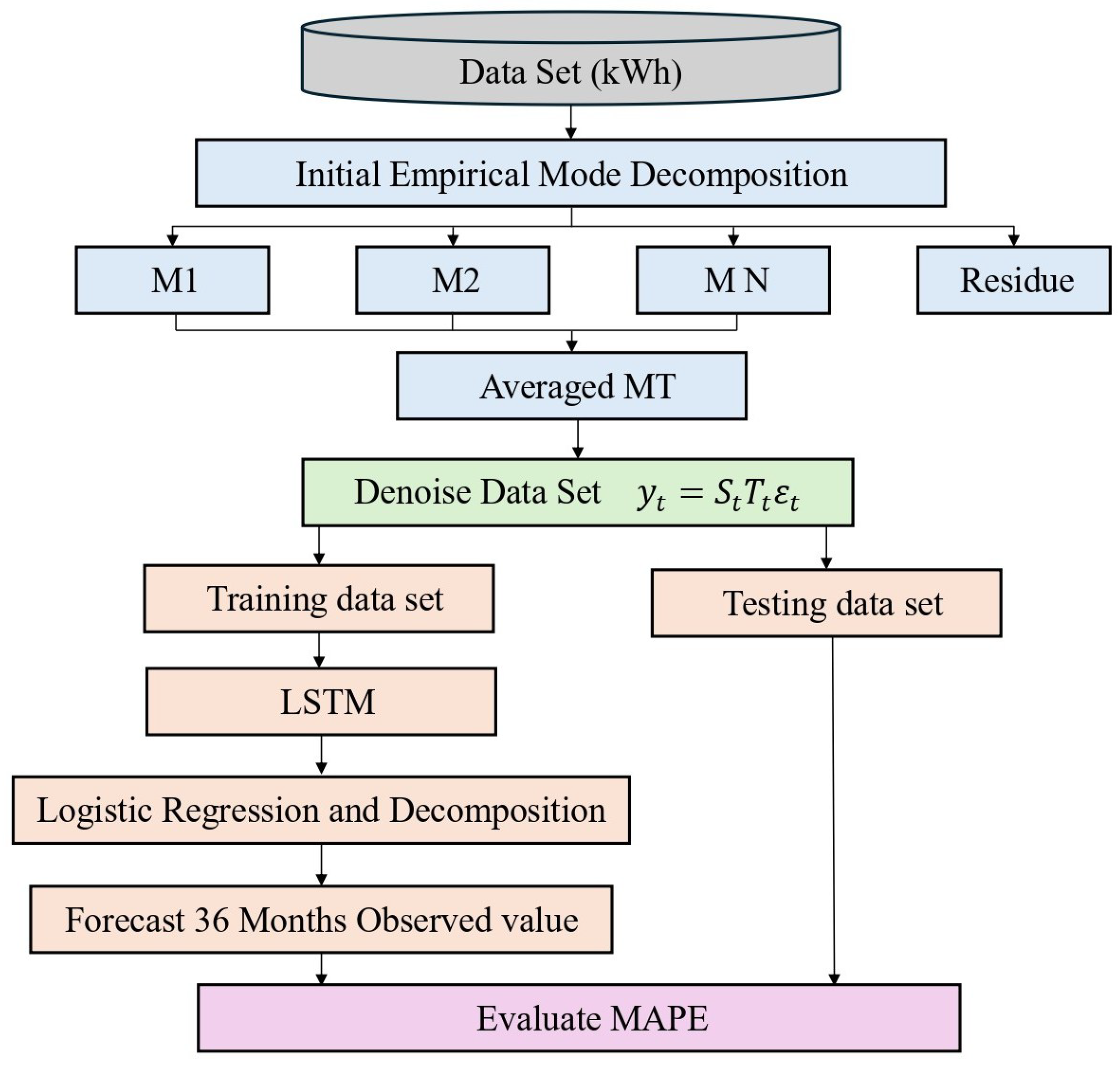
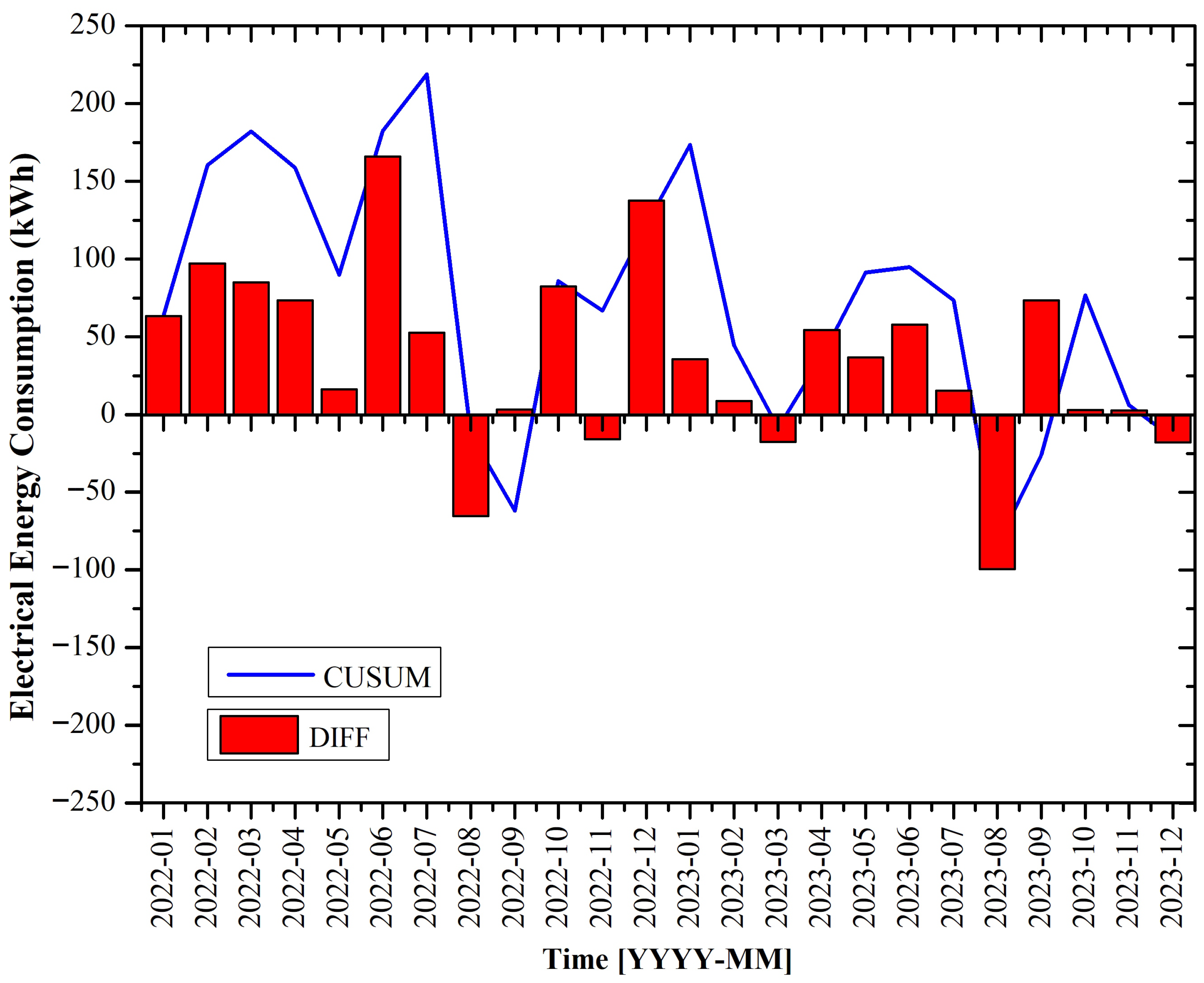

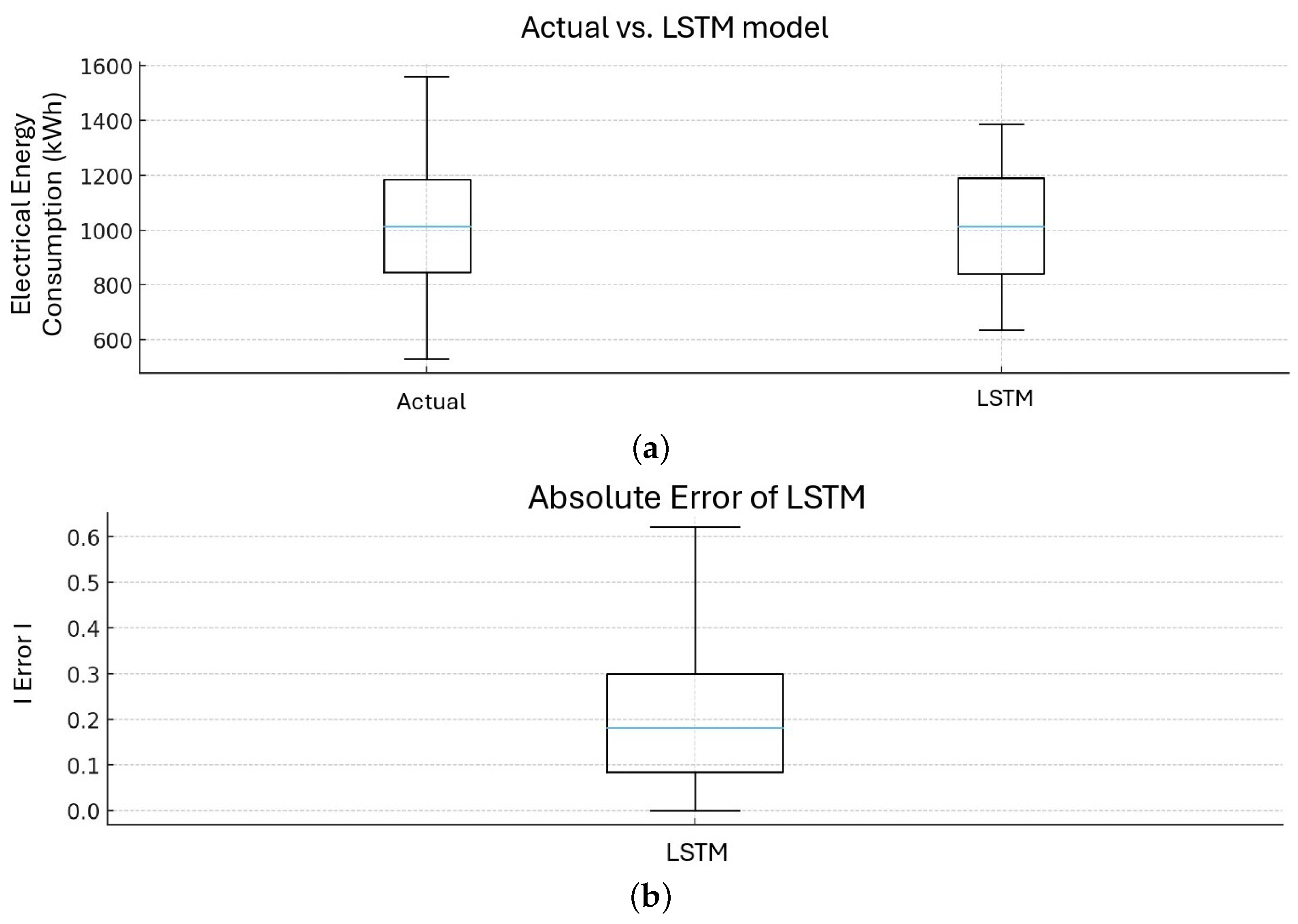
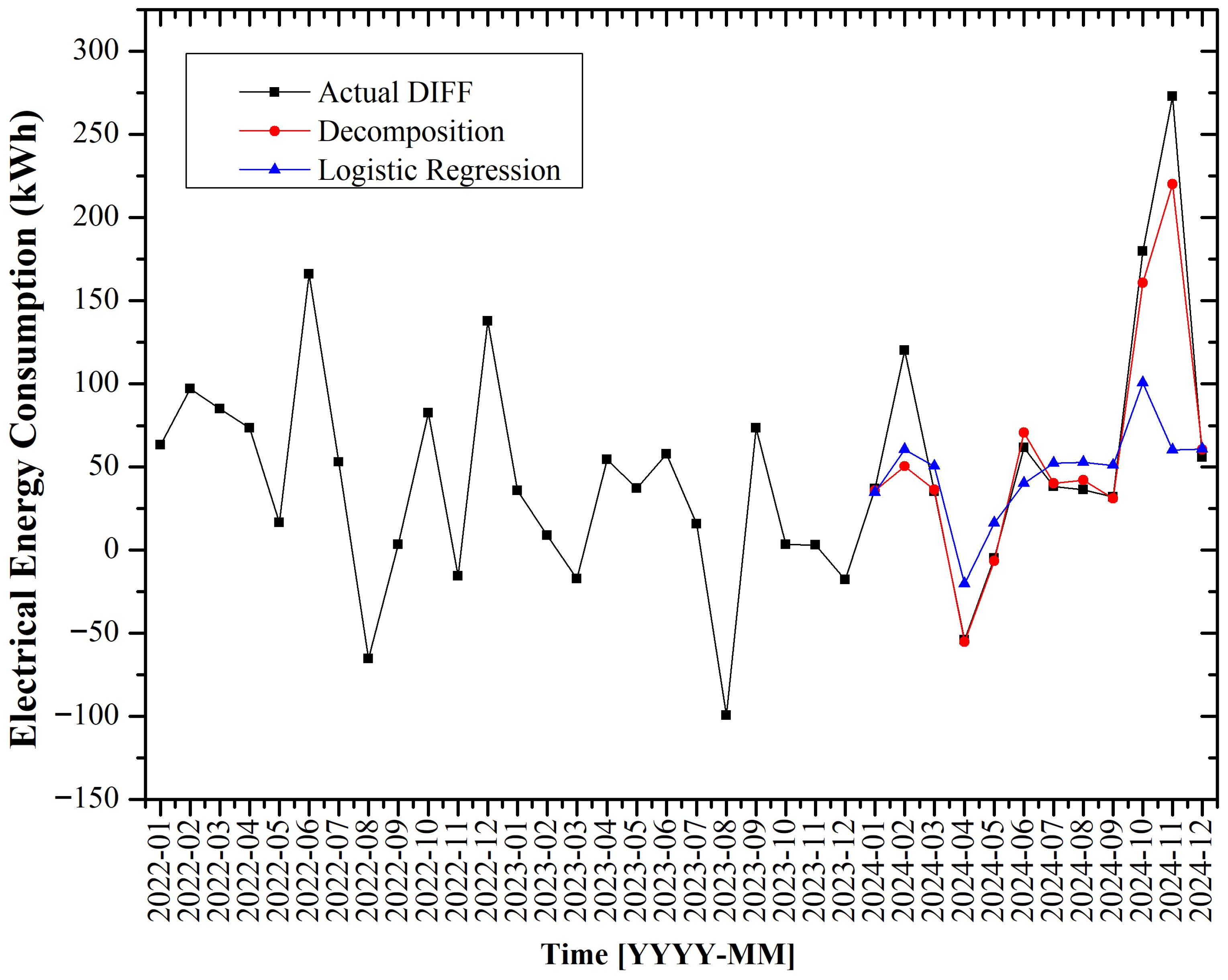
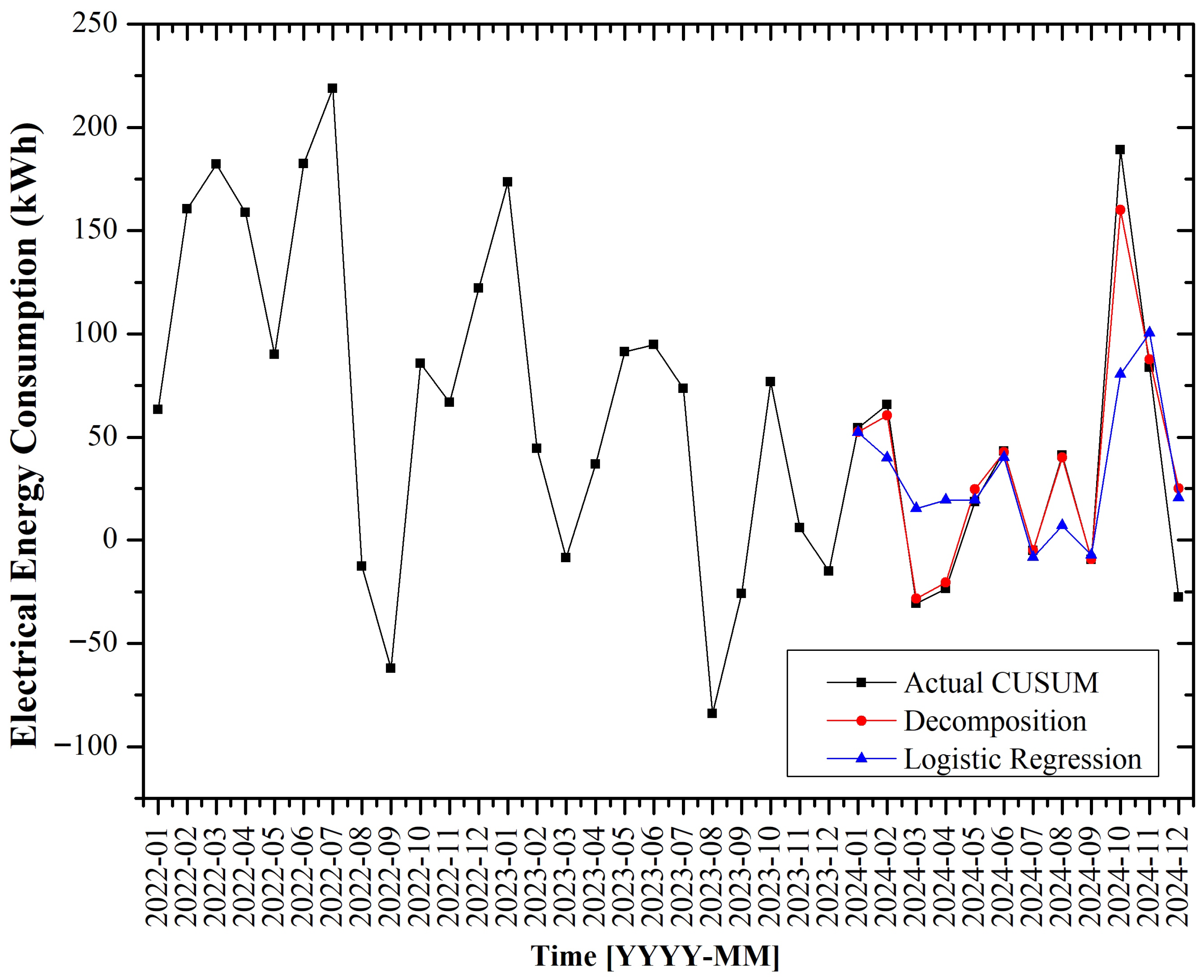
| YYYY-MM | Production Volume (kg) | Electrical Energy Consumption (kWh) | Baseline-Calculated Electrical Energy Consumption | DIFF | CUSUM |
|---|---|---|---|---|---|
| 2022-01 | 100.5 | 1600.64 | 1537.17 | 63.47 | 63.47 |
| 2022-02 | 101.5 | 1612.66 | 1515.6 | 97.07 | 160.53 |
| 2022-03 | 91.5 | 1398.92 | 1313.82 | 85.1 | 182.16 |
| 2022-04 | 101.5 | 1589.14 | 1515.6 | 73.54 | 158.64 |
| 2022-05 | 105 | 1602.66 | 1586.22 | 16.44 | 89.98 |
| 2022-06 | 77.5 | 1197.25 | 1031.33 | 165.93 | 182.37 |
| 2022-07 | 103 | 1598.69 | 1545.86 | 52.83 | 218.75 |
| 2022-08 | 96 | 1339.17 | 1404.62 | −65.45 | −12.62 |
| 2022-09 | 100.5 | 1498.69 | 1495.42 | 3.27 | −62.17 |
| 2022-10 | 101.5 | 1598.11 | 1515.6 | 82.51 | 85.78 |
| 2022-11 | 101.5 | 1598.11 | 1515.6 | 82.51 | 85.78 |
| 2022-12 | 101.5 | 1653.36 | 1515.6 | 137.76 | 122.13 |
| 2023-01 | 105 | 1621.9 | 1586.22 | 35.68 | 173.44 |
| 2023-02 | 105.5 | 1605.14 | 1596.31 | 8.83 | 44.51 |
| 2023-03 | 106.5 | 1598.97 | 1616.49 | −17.52 | −8.69 |
| 2023-04 | 98 | 1499.42 | 1444.97 | 54.44 | 36.92 |
| 2023-05 | 108 | 1683.67 | 1646.75 | 36.91 | 91.35 |
| 2023-06 | 100.5 | 1553.36 | 1495.42 | 57.94 | 94.85 |
| 2023-07 | 101.5 | 1531.11 | 1515.6 | 15.51 | 73.45 |
| 2023-08 | 101.5 | 1531.11 | 1515.6 | 15.51 | 73.45 |
| 2023-09 | 101.5 | 1589.19 | 1515.6 | 73.59 | −26.01 |
| 2023-10 | 105 | 1589.36 | 1586.22 | 3.14 | 76.73 |
| 2023-11 | 105.5 | 1599.11 | 1596.31 | 2.8 | 5.94 |
| 2023-12 | 106.5 | 1598.69 | 1616.49 | −17.8 | −15 |
| YYYY-MM | %MAPE (DIFF) | %MAPE (CUSUM) | ||
|---|---|---|---|---|
| Decomposition | Logistic Regression | Decomposition | Logistic Regression | |
| 2024-01 | 3.00 | 5.67 | 3.63 | 3.82 |
| 2024-02 | 58.12 | 49.64 | 7.86 | 39.08 |
| 2024-03 | 3.49 | 44.37 | 7.99 | 149.87 |
| 2024-04 | 2.08 | 62.23 | 13.26 | 181.83 |
| 2024-05 | 29.43 | 411.89 | 33.46 | 5.04 |
| 2024-06 | 14.57 | 35.19 | 1.09 | 7.03 |
| 2024-07 | 5.31 | 37.86 | 7.07 | 58.70 |
| 2024-08 | 16.56 | 47.06 | 2.40 | 83.04 |
| 2024-09 | 3.11 | 59.86 | 2.44 | 22.59 |
| 2024-10 | 10.55 | 44.01 | 15.39 | 57.43 |
| 2024-11 | 19.26 | 77.89 | 4.72 | 19.96 |
| 2024-12 | 8.19 | 8.77 | 190.31 | 173.87 |
| Average | 14.47 | 73.70 | 24.13 | 66.85 |
Disclaimer/Publisher’s Note: The statements, opinions and data contained in all publications are solely those of the individual author(s) and contributor(s) and not of MDPI and/or the editor(s). MDPI and/or the editor(s) disclaim responsibility for any injury to people or property resulting from any ideas, methods, instructions or products referred to in the content. |
© 2025 by the authors. Licensee MDPI, Basel, Switzerland. This article is an open access article distributed under the terms and conditions of the Creative Commons Attribution (CC BY) license (https://creativecommons.org/licenses/by/4.0/).
Share and Cite
Chinnaket, S.; Michel, P.C.; Chansri, P. Forecasting Trends in Electrical Energy Efficiency in the Food Industry. Energies 2025, 18, 5667. https://doi.org/10.3390/en18215667
Chinnaket S, Michel PC, Chansri P. Forecasting Trends in Electrical Energy Efficiency in the Food Industry. Energies. 2025; 18(21):5667. https://doi.org/10.3390/en18215667
Chicago/Turabian StyleChinnaket, Saksirin, Pasapitch Chujai Michel, and Pakpoom Chansri. 2025. "Forecasting Trends in Electrical Energy Efficiency in the Food Industry" Energies 18, no. 21: 5667. https://doi.org/10.3390/en18215667
APA StyleChinnaket, S., Michel, P. C., & Chansri, P. (2025). Forecasting Trends in Electrical Energy Efficiency in the Food Industry. Energies, 18(21), 5667. https://doi.org/10.3390/en18215667







